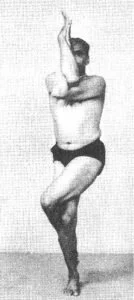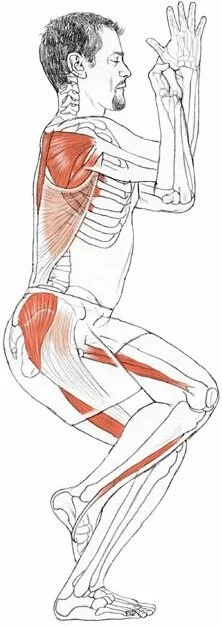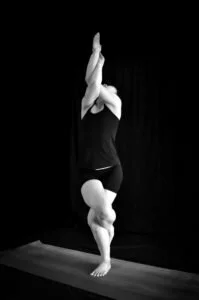 Garudasana (gah-roo-dah-sah-nah; Sanskrit: गरुडासन; IAST: Garuḍāsana) or Eagle Pose is an asana.
Garudasana (gah-roo-dah-sah-nah; Sanskrit: गरुडासन; IAST: Garuḍāsana) or Eagle Pose is an asana.
The name comes from the Sanskrit words garuda meaning “eagle”, and asana meaning “posture” or “seat”.
In Hindu mythology, Garuda is known as the king of birds. He transports the God Vishnu and is eager to help humanity fight against demons. The word is usually rendered into English as “eagle,” though according to one dictionary the name literally means “devourer,” because Garuda was originally identified with the “all-consuming fire of the sun’s rays”.
This standing asana may enhance concentration. It focuses on the ankles, calves, thighs, hips, and shoulders.
Step by Step:-
- Stand in Tadasana. Bend your knees slightly, lift your left foot up and, balancing on your right foot, cross your left thigh over the right. Point your left toes toward the floor, press the foot back, and then hook the top of the foot behind the lower right calf. The balance on the right foot.
- Stretch your arms straight forward, parallel to the floor, and spread your scapulas wide across the back of your torso. Cross the arms in front of your torso so that the right arm is above the left, then bend your elbows. Snug the right elbow into the crook of the left, and raise the forearms perpendicular to the floor. The backs of your hands should be facing each other.
- Press the right hand to the right and the left hand to the left, so that the palms are now facing each other. The thumb of the right hand should pass in front of the little finger of the left. Now press the palms together (as much as is possible for you), lift your elbows up, and stretch the fingers toward the ceiling.

- Stay for 15 to 30 seconds, then unwind the legs and arms and stand in Tadasana again. Repeat for the same length of time with the arms and legs reversed.
Anatomical Focus:-
- Ankles
- Calves
- Thighs
- Hips
- Shoulders
Therapeutic Applications:-
- Asthma
- Low backache
- Sciatica
Benefits:-
- Strengthens and stretches the ankles and calves
- Stretches the thighs, hips, shoulders, and upper back
- Improves concentration
- Improves sense of balance
 Contraindications and Cautions:-
Contraindications and Cautions:-
Students with knee injuries should avoid this pose, or perform only the leg position described in the Beginner’s Tip below.
Beginner’s Tip:-
Beginners often find it difficult to wrap the arms around until the palms touch. Stretch your arms straight forward, parallel to the floor, while holding onto the ends of a strap. Follow the rest of the instructions stated in step 2 above and keep the strap taut between your hands.
Beginners also find it difficult to hook the raised-leg foot behind the standing-leg calf, and then balance on the standing foot. As a short-term option cross the legs but, instead of hooking the raised foot and calf, press the big toe of the raised-leg foot against the floor to help maintain your balance.
Follow-Up Poses:-
Garudasana is usually sequenced near the end of the standing pose series. The arm position in the pose is particularly useful in teaching how to widen the back torso in inverted poses like Adho Mukha Vrksasana and Sirsasana. Other follow-up poses might include:
- Gomukhasana
- Utkatasana
- Vrksasana
Deepen the Pose:-
Look at the tips of your thumbs once you’re in the full pose. Typically the thumb tips point a little bit off to the side of the upper arm. Press the mound of the upper thumb into the bottom hand and turn the thumb tips so they point directly at the tip of your nose.
Variations:-
Usually, Garudasana is performed with a straight spine, so that it shows the mythical bird Garuda. But most people make their spine round, which could be interpreted as a mistake or a variation.
